The Languages of Meditation
Meditation is used by so many different types of people – mommies with babies at home, mothers with schoolchildren, stay-at-home dads, working parents, teenagers, college students, athletes of all kinds, entrepreneurs, artists, dancers, film makers, actors, writers, soldiers, veterans, physicians, psychologists, therapists and healers of all kinds, spiritual seekers, retired people, people who are in the process of dying, caregivers, surgical patients, explorers, wanderers, and lovers of life. And each of these may need the language of instruction to be customized to make sense to them.
There is no one language of meditation that communicates to everyone, any more than there is one shoe size everyone should wear, or one food everyone should eat. In this training, you can select your own subset of meditation jargon to learn. For example, you can choose to totally ignore the Sanskrit terms, or you can embrace them. For some populations, Sanskrit is distancing, elitist, and confusing. For others, it is thrilling. You can choose use the language of the physiological effects of meditation, and learn about the functioning of the nervous system, or you can just have an overview of the relationship of the relaxation response and the stress response.
You will be encouraged to learn and customize for your own use simple, sensible language for instruction, that is known to be effective for a wide variety of people coming to learn meditation.
Interviews with meditators of all kinds reveals that a high percentage struggle with meditation for years and generally give up, and struggle with trying to impose foreign, inappropriate concepts on themselves.
By languages here, I mean the different interior languages people interpret the world with.
- Language: a body of words and the systems for their use common to a people who are of the same community or nation, the same geographical area, or the same cultural tradition:
- any set or system of such symbols as used in a more or less uniform fashion by a number of people, who are thus enabled to communicate intelligibly with one another.
- any system of formalized symbols, signs, sounds, gestures, or the like used or conceived as a means of communicating thought, emotion, etc.:
- the language of mathematics; sign language
- the means of communication used by animals
- the language of birds
- communication of meaning in any way; medium that is expressive and significant
- the language of flowers
- the language of art
Whatever you say to your students by way of meditation instruction, they will interpret that according to what they already know how to do, and try to accomplish what they hear you saying. In order to be effective, it helps to be aware of the different internal languages people may be aware of:
The language of the senses and sensations
The language of the instincts
The language of rhythm
The language of the elements
The language of emotion and emotional experience
The language of athletic skill
The language of yoga
You will gain a broad appreciation of the richness of meditative experience, and will be encouraged to specialize in areas that most interest you. Whether you are working with mommies and babies, jocks, pilots, teachers, lovers, soldiers, corporations, or just regular people, you will be able to develop your own language you are most comfortable with that suits your personality and skill level.
This month, pay special attention to your senses, and to the way other people describe their sensory world. Of course the senses are never separate from the emotions, the instincts, and the elements.
The Language of the Senses

Source: The New Scientist
The Language of Sensations
Get familiar with the world of sensations . . .
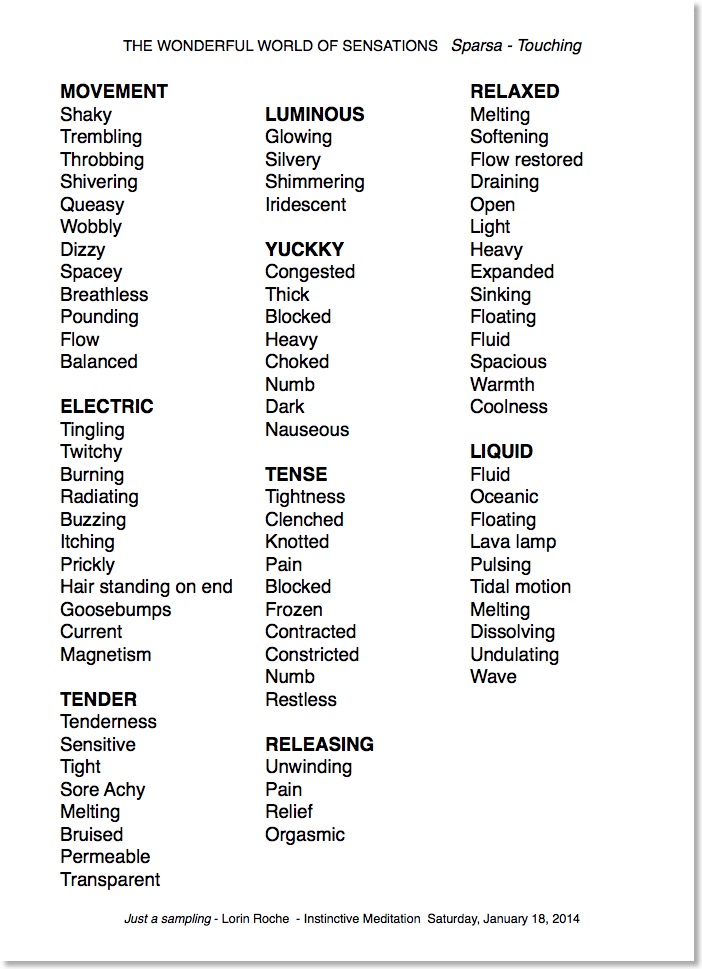
What sensations are arising in your body right now?
Where are they located?
How are they changing?
If you give attention to the sensations, how do they change?
If you give tenderness and love and appreciation to the sensations, what happens?
Here is a sensory meditation you can adapt to your everyday life . . .
Salute the Senses
Time: 3 minutes to 5 minutes for each sense.
Posture: Standing, walking, lying down or sitting.
When: Anytime except when operating heavy machinery.
Let’s take a tour of some of the more commonly known human senses. All of them are employed in the various meditation techniques of the world, by themselves and in combination.
Attention and mindfulness happen through the senses. When you are aware of thinking, it is through internal sensing: you see a mental image in “your mind’s eye,” you hear a thought or you feel one. You can even call up thought-smells.
The meditations in this chapter touch in with all the senses, not just seeing and hearing and taste and touch and smell, but also balance and movement. Take your time to explore these brief sensory salutations, at your own pace. You could take a year or you could take a month to go through them. If you are on vacation, you could do them in a couple of days. But the real effects will show up over the long run, over the months and years.
The first few times you do one of these exercises, it may take many minutes to engage fully with one of the senses and experience its range. Over time, by simply thinking of one sense for a moment, it will awaken. Tuning into each of your senses every day will enrich your life in subtle and wonderful ways.
The more you let your senses open up and rejoice in meditation, the better. When you pay attention to a sense, it comes alive. If you do so consistently, the brain literally creates more neural pathways to appreciate that sense.
The brain rewires itself on a daily basis to be better at what we are paying attention to. When you exercise a sense, the brain makes more neural connections for that sensory pathway. When you connect that sense with other senses, the brain makes connective pathways to coordinate perceptions. This is one of the things that makes meditation so much fun, because you are progressively having a richer experience of your body and your world as you move through your daily life.
As you read through the following paragraphs, linger a bit and evoke your senses, call up your favorite ways of experience. Take an attitude of playful idleness when exploring the senses, at least the first couple of times you explore each sense. Play and childlike curiosity engage your instincts in a healthy way, and help you establish a sense of easy familiarity with your senses. In an informal approach to meditation, this is the way to go.
Doing the salute to the senses is very simple, and not at all profound. After all, these are the senses you use all the time, to know where you are in the world and how you are doing. The exercises starting on the next page are ways of celebrating everyday sensuous perceptions. You will be choosing a sense — hearing, or touch, or vision — and paying attention to it closely. It does not take much to awaken the senses; even the lightest touch suffices to start the process. The payoff is usually immediate — we find ourselves just a little bit more alert to the beauty of the world around us. Go for those tiny changes.
Grab some mini-meditations here and there throughout your day. Two minutes here, thirty seconds there. These will teach you how to develop a meditation practice that you want to do each day. And that is the whole point.
Smell
How it works:
Smell is a chemical sense that allows us to detect the electric charge on molecules as they flow across receptors in our noses.
Explore:
What are some of your favorite smells? Choose one that is available to you right now, and let it become the center of your attention. It could be a stick of cinnamon, a piece of chewing gum, a leaf, a cigar, a rose, brandy in a snifter, the smell of the leather on your pocket organizer, the perfume or cologne on your wrist. You could just go sit in a garden and breathe. Right now I thought of a peach, and one was available so I held it up to my nose, breathing in and out for several minutes, studying the smell.
Salute to Smell
1. Select something with a smell you want to enjoy. If possible, have it in your hand. It could be a piece of orange, a flower, a bottle of perfume, chocolate, wine, a cigar, anything. If possible, have fresh air, or clean air.
2. Sit in a comfortable place.
3. Hold the item near your nose and breathe in the scent.
4. Notice where in your nose the sense of smell seems to come from.
5. Be aware of changes in the experience of smell as you become saturated with the odor.
6. Be alert to sensations coming from your entire body as you breathe the smell in and out. Depending on your mood and the nature of the smell, you might have tingling or melting sensations in your belly, genitals, heart area, legs, or on your skin. The smell might be evocative of emotions, so let those emotions move through you and attend to them as long as you like, then return to the sense of smell. If the emotions come back and are strong, attend to the places in your body with physical sensations that correlate to the emotion. If for example, a perfume reminds you of a time and place you once wore it, and you have a longing about that, is the longing in your heart area? Is it in your gut, your belly? Is it in your entire upper torso?
7. After several minutes, move the item away, so there is only the barest hint of it.
8. After several more minutes, move the item further away, so that there is no discernable hint of it. There is only the possibility that a molecule of it here or there will reach your nose.
Yet, stay alert in your nose to the possibility of smell, and continue being aware of breathing, being alert to the presence of nothing in the air. You are alert, you are mindful in the nose, but there is nothing there except pure air. This exercise is really about waking up to smell.
Over time, this meditation will increase your alertness to the sense of smell, even the smell of pure clean air. You can be sitting under a tree, or on your sofa, and draw in a breath of fresh air and enjoy air. You can draw energy out of air. You can draw calmness out of air. You can draw any quality you crave out of the air. If you cultivate your sense of smell, you will also cultivate your ability to be alert to the whole process of breathing, and your meditations will be that much more enjoyable.
Taste
How it works:
Taste is a chemical sense that detects the ions and molecules touching your tongue.
Explore:
What are some of your favorite tastes? I just ate some sushi, and the taste of the ginger and horseradish is lingering in my mouth. Is there anything around that you would like to taste? Take a little nibble of it.
Salute to Taste
Water is our most essential need after air. Water has a taste when we are thirsty, it tastes good. Even distilled water tastes good. You could also use fruit juice or wine.
1. Taste a sip of water. Little by little. Do not completely satisfy your thirst until later.
2. Notice how the water affects the sensations in your mouth. Where are you experiencing taste? How does your tongue, the top of your mouth, the back of your throat welcome the water? Have you ever noticed this before?
3. Scan your body for sensations that go with drinking water. What happens in your belly? How does your attitude change as you sip?
4. After a couple of minutes, gulp as much of the water as you like. Gulp attentively if you can. Notice the sensations in the belly. Check out your body for the subtle, pleasurable sensations of being satisfied.
When you have gotten used to this, you may find that anytime you drink water you can turn on your sense of taste and really enjoy. It may take only two seconds, but you have enjoyed a simple everyday experience.
If you like, you could use a sip of water at the beginning of a meal to key you in to enhanced taste. You may find this helps you to eat just as much as you need, and to enjoy it more, and not get into any control issues with food. This is one of the purposes of having wine with meals. There is so much to smell in a glass of wine, and every sip has such complex taste, that the whole body is prepared for sensual enjoyment of food.
Your experience may be very different each time you do this exercise. It will depend on your state of relaxation, how hydrated you are, the outside temperature and humidity, your emotional state, where you are, and the particular water you are tasting. You may have emotions come up, relating to times when you were really thirsty. You may have pictures come into your head. Be with the emotions and pictures, and when they fade away, return to the sense of taste. Every time your mind wanders, it is clearing out the cobwebs and bringing the richness of memory to the present moment.
Sight
How it works:
Special cells in your retina contain molecules that respond to waves of light that pulse in the range of about four hundred trillion to eight hundred trillion times a second. Your brain translates this into the experience of color, texture, depth, shape, and motion. A great deal of the brain is devoted to visual processing.
Explore:
Let your gaze wander around the room or area you are in right now. Notice how effortlessly the eyes move. Release the eyes from any control and just let them move wherever they want.
Salute to Sight
1. Let your eyes move around and then alight on some color that calls you. Allow your eyes to rest on the color. The eyes may move, but they can also feel at ease. Ask yourself, what colors or sights do I crave right now? Would you like to be in Tahiti, looking out over the ocean? In a forest or in the mountains? Looking at the body of your lover? Let images stream though your mind’s eye if you like.
Different people crave different colors and there is sometimes a sensation of being touched by light, when the light is right and the mood is right. Be alert for subtle sensations in the eyes as you notice your reaction to color.
The eyes can feel extraordinarily restful while seeing. Sometimes we reach out to grab the world with our eyes, but we can also experience being receptive to color — which is the case in reality. The eyes move, but the electromagnetic spectrum enters the eyes and makes the molecules excited.
2. Now do the same with the texture of the visual world. Texture is the surface of the objects you are seeing. Choose a texture that appeals and alight on it with your eyes. Be aware of texture for half a minute.
3. Do the same with the depth of field. Notice you can tell how much empty space is between you and all the objects you see. Notice the empty space, the air between you and the objects you are seeing.
4. Become aware of your peripheral vision. Rest the eyes on some spot in front of you, and with the peripheral vision, see to the left and right, above and below.
5. Notice the element of shape in the objects you are seeing. And if the objects are moving or static, how they sit in space.
Just touch on these for half a minute or so. Your aim is to simply notice some of the range and quality of vision, and stay there for a few seconds.
Hearing
How it works:
Inside each ear is a resonant chamber with tens of thousands of tiny hairs of different lengths. Each vibrates to a different frequency of sound waves, setting off nerve cells. Your brain takes the impulses coming from these cells and sends the data swirling around intricate neural circuitry. This gives you the experience of tone, resonance, amplitude, direction, and many other wonderful qualities. The filtering mechanism lets you pick one conversation out of many at a party.
Explore:
Is there a simple sound that you would like to hear? Or would you prefer silence? Give yourself a moment to wonder what quality or intensity of sound or silence you would like to experience.
Salute to Hearing
1. Sit in a place where there is a sound you like, perhaps a fountain or a bird. Or sit where you are and listen to the sounds of life around you, whether it is distant traffic, kids playing in a yard, the television in the next room, or someone walking back and forth above you.
2. After listening with the eyes open for a minute or two, close the eyes and continue listening. Let yourself keep track of what is going on, and notice the three-dimensionality of sound. If you have two functional ears, you can locate noises in all directions, including up and down.
3. Begin to pay attention to the relative quiet between sounds — if there is any. If not, then notice the space between you and the source of the sounds. You can usually tell, by listening, how far away the source of the sound is.
4. Put your attention in the ears themselves and be awake there, listening and feeling. This will be easier if the sounds around you are not too loud.
Touch
How it works:
In the skin are many sensors for detecting touch, pressure, heat, and pain, and each of these has its own specialized nerve terminals. Just within touch itself, there are nerves for sensing the light contact that moves the hairs, a touch on the skin surface itself, and a strong touch. The skin has sensors near the surface and down deep into the tissue.
Explore: Check in with your body right now and ask yourself, what touch do I want? Touch anything with eyes closed and experience the sensations in your fingertips and palms, as if touching for the first time. Touch your skull very lightly and lovingly; let both your hands and the skin of your scalp be awake to each other.
Salute to Touch
1. Starting at the top of the head, with an extremely light touch, move down the midline of the body. Move extremely slowly. Use one hand, perhaps the middle finger. Go as far down as you feel comfortable.
Experiment by moving your hand or finger away from the body, then move it back in slowly and notice the point where you can tell your finger is about to touch.
2. Notice what areas of the body crave to be touched lightly. Explore the forehead, the eyelids, the lips, the hollow of the throat, the area between the breasts, the belly, and if you are so inclined, areas around the genitals.
3. Hold the hands in front of the chest, palms inward, and move them in and out a few inches as you breathe. On the inbreath, let the hands come all the way in and lightly touch the chest. On the outbreath, move them slightly out.
Each area of the body has its own relationship with touch and preference for kinds of touch. The lips, hands, and genitals have lots of nerve endings.
Variations: Touch different textures, such as fur, silk, velvet, carpet, wool, wood and glass. Touch different areas of your skin. Have someone touch you all over very lightly. Have someone breathe on your skin. Experiment with different pressures, light and strong, fast and slow. In terms of touch, meditation sometimes feels like the most delicate foreplay imaginable.
Kinesthesia
How it works:
There are nerves in the muscles themselves to detect stretch and tension, and there are nerves in the joints of the body to detect position. You can notice these all the time when you are sitting or lying down and breathing, or when walking, running, swimming, dancing, making love, and doing yoga.
Explore:
Consider the many movements you do everyday, from the time you get out of bed in the morning to the time you go to sleep at night. Which movements do you love in particular? Which ones do you pay attention to? Which ones would you miss terribly if you weren’t able to do them any more?
Salute to Movement Sensing
1. Let one or both of your hands move as if you were gesturing in a conversation. But let the movement be very slow. Now close your eyes and continue, noticing not only the sensations in your arms and hands, but all over your body.
2. Let the movements gradually become slower and slower until you are moving so slowly that even you can’t tell if you are moving or not.
3. Stand with the eyes closed and swing your arms from side to side. Move with vigor and enthusiasm and then slow down gradually. Notice how you detect movement. Notice how it makes you feel, how it changes your mood.
Still standing there with eyes closed, know where your joints are in space. You can tell instantly. Simply notice that you know where your joints and limbs are.
Balance
How balance works:
Near the inner ears are semi-circular canals (vestibules) filled with fluid. Whenever the fluid moves, it causes movement in tiny hairs lining the canal, and sensors detect this. The brain interprets this information as the relationship with gravity, the mysterious attraction matter has for matter. Balance, also called the vestibular sense, alerts your brain continually to the relationship of the body to the center of the earth.
Exploration:
Whenever you are moving, accelerating, standing, sitting, or lying down you are enjoying the sense of balance. But the vestibular sense works so seamlessly, and melds so beautifully in cooperation with vision and kinesthesia, that we rarely experience it in itself. Any time you lean over, you can feel gravity attracting you.
Salute to Balance:
1. Sitting with eyes closed, tilt your head very slightly one way and then the other, left then right. Notice the sense that informs you when your head is at the centerline. Let your movements be tiny, a fraction of an inch.
2. After you get used to the small head movements, explore doing tiny spiral or circular motions around where the center is, around where perfect vertical is.
3. There is an exquisite feeling right at the vertical. You can sense this if you are moving slowly enough. Continue to play with being off-center, then “falling upwards” toward center. When you get used to this sense of vertical, through playing around with being slightly off-balance, there comes a sense of great pleasure in being upright.
Your Relationship With the Senses
These senses are all used in meditation. Stay with any of these sensuous modalities for a minute or so, to let yourself be reminded of what’s real. Each sense is both external — as in hearing a sound — and internal, as in hearing the thought of the sound or hearing yourself think. Anyone with the sense of hearing can call up at will a remembered sound, and similarly people can call up an image or a feeling. Each sense reaches into the outer world and into the inner world.
The senses blend and interact with each other constantly, and a single sense rarely operate in isolation. When you are eating, you see the food, smell it, taste it, feel the motion as you bite into it, and feel it move around in your mouth before swallowing it. Then you feel satisfied, which is yet another sensation. When you are walking, you look around, smell the air, hear cars and people on all sides of you, feel the motion in your legs, and feel hot or cold. When you are in a passionate embrace, there is something for every sense to enjoy. When you are listening to music, you will find that you are not only processing auditory signals, but kinesthetic information from all over your body. And whatever you are doing, sitting still or moving, your sense of balance is always there informing you.
In meditation you use the same senses that you do when you are enjoying yourself. So the more intimate you get with the senses, the better. As you salute each of the senses, you give it permission to interact with the others in new ways.
Take the time to make a sensuous inventory. What are your dominant senses? What are your least developed? Be willing to refresh your relationship with each of the sensory pathways. Each connects you to the outer world and the inner world in a different way, and the variations and combinations are infinite.
Although this may seem extremely simple, saluting the senses is a profound exercise. Even a few minutes a day of this will over time change your experience of life in interesting and useful ways.
If you are a beginner at meditation, then you have a great advantage. You have not yet learned to split “the spiritual” from common everyday sensuous perception. And if you do not ever split yourself in this way, then you will not have to quit meditating someday in order to recover from the split and re-unify yourself.
The more alert you are to all of the senses, the richer your meditations will be, the more textured your sense of your inner world. Even thinking is a sensory experience; when we are thinking, we see inner pictures, we move them around and look at them from different angles, we listen to our internal dialogues, and we feel different body sensations with each of the scenarios we create.
Meditators often get into a rut with their senses, using the same ones in the same way every day. If you say to someone, “scan your body,” or “pay attention to breath,” they will use whatever senses they are used to working with. But even in a simple experience of breath, there is sound, movement, touch, balance and perhaps smell. The more senses you enjoy in meditation, the richer your experience will be. It only takes a minute to orbit through all the senses and give them permission to play. When you get intimate with a sense, you are saying to it, “Talk to me, tell me your story. What do you want?” The senses always answer, each in their own unique way.
After meditation, go and use your senses.
* If any of your senses are impaired, you can still salute it. You can even salute its absence! Whenever we are deprived of one sense, the others become more sensitive to compensate. So if you have any issues with any of the senses, be creative in inventing and adapting. I have always envied people who speak ASL (American Sign Language) and other sign languages, because they are so beautiful to watch. Some day I want to meet a meditation teacher who is deaf and has explored the use of sign-language in meditation.
All Senses Meditation
Time: Five to ten minutes
Posture: Sitting is preferable. You can also experiment with doing it lying down or standing.
When: Anytime.
This exercise lets you play with orbiting through your senses and observing something in each.
1. Sit or stand anywhere you like and let yourself “get in” for a minute. Do any settling-down movements that you want. Stretch or yawn. Then notice the ebb and flow of your breathing.
2. Begin to speak softly, saying “Now I am aware of seeing . . .” And say whatever comes to mind that is visual, whether it is in the outer world or a mental image. The sentence can be said very slowly. Continue like this for one minute or so, just speaking the sentence, “Now I am aware of seeing . . .”
3. When you get to the word, “seeing,” say whatever image your mind or eyes are on at that exact moment. As in “I am aware of seeing the rain.”
4. Switch to another sensory mode. “Now I am aware of smelling . . .” and say whatever you are smelling.
5. Continue this way, starting each sentence with “Now I am aware,” and then choose another sense. Improvise off of your immediate perceptions.
Note: What happens is that our primary perceptions, unsocialized, get a chance to come out without editing. This trains you to let yourself be surprised by perception, to let new and fresh perceptions emerge.
This also lets you practice giving speech to your immediate perceptions. Since being a child, you may not have had a chance to speak freely without editing first.
NOTE: Move through each sense in any order you wish:
Now I am aware of seeing...
Now I am aware of smell...
Now I am aware of hearing...
Now I am aware of tasting...
Now I am aware of touching...
Now I am aware of moving...
Now I am aware of balance...
We Can Even Perceive Thoughts as Sensory Phenomena
Sensory Experience in Meditation
What do people experience when they meditate?
There are various kinds of thoughts that people talk about:
restless thoughts
planning thoughts
memories of past experiences
painful thoughts
imaginations of desired experiences
repetitive thoughts
There is also:
being absorbed or lost in thoughts
a light cloud of thoughts
There are thoughts about thoughts:
“I am having too many thoughts.”
“That thought over there is cheeky, it shouldn’t be allowed in here.”
“I really shouldn’t be thinking this . . .”
“I must not be a good meditator, I am thinking so much”
“I wish these thoughts would go away”
“Grrrr . . . get out of my mind, damn thoughts!”
Or: “Hey, that’s a pretty interesting thought, maybe I’ll sneak off and play with it for a bit.”
How do I know that I am thinking?
think about it—how do you know?
do thoughts hit you?
do they float through your mind like clouds?
grab you by the throat?
whisper or yell at you?
appear on the screen of your mind?
move up from your belly?
Thoughts can be experienced as sensory phenomena.
Thoughts are always sensory phenomena.
for example — thoughts as seeing
mental images: you can look at thoughts. When you see a thought, you can attend to it more closely by noticing:
—is it a still photo mental image or a moving picture series of images.
—if it’s a moving image, is it a repetitive tape loop or
an ongoing epic? Is it moving slow motion or regular speed or fast?
—what size is the image in your field of inner vision?
—what is the point of view? where is the camera?
what about the light source: is it sunlight (and is it from above, as in mid-day, or sunrise or sunset) or is it artificial light (from the side or above)?
is there abstract imagery or graphics?
has your mind constructed scenes or are you looking at photographic images?
black and white or color?
is the image fine grain, like a good photo or movie, or grainy,
like television?
is the focus clear, or is it fuzzy?
perspective — what’s the angle of view? straight on, looking up from below, looking down from above.
wide-angle lens, telephoto lens?
what’s the background imagery, the figure/ground relationship?
are the surrounding things in clear focus?
also, are they lit up or in shadow?
size of screen — square, rectangular, round?
is there a frame around the image?
distance of the screen from your mental eye
three-dimensional or flat?
wrap-around panavision or right in front of you or to the left/right
Other kinds of internal seeing
dancing particles, microscopic luminous somethings
directions of movement and dimensions of vibration
qualities of space, depth
the sense of hearing
We can hear music, notes, melodies, voices, and faint sound effects that we barely notice, like the sound track to a movie or TV show.
Sounds in our inner sensing can be stereo or mono or surround sound.
Sounds can be loud or soft, far away or close to us, rhythmic or steady.
Sounds can be distinct or faint, and change from one to the other in a split second.
mental conversations
is it a memory of a conversation or something constructed?
tape loop of the same voice, same words or improv?
tone of voice? pleading, commanding, blaming, criticizing,
complaining, demanding, apologizing, questioning, praising.
is the voice your own voice, an abstracted voice?
directionality: is the voice coming from the left or right side,
from the middle, or from below or above? does it move around?
mono or stereo sound effects?
subtle sounds
internal sounds, such as the vowel sounds, continue by themselves
resonances permeating the body or
focussing in one of the centers of the body or along the spine
echo
vibration
harmonics of the sounds - rich chords
sounds becoming faint, barely perceptible
a feeling of being inside of the sounds or surrounded by a field
of sound, or permeated by sound
hearing the sounds of the silence
energy sounds, hearing the energy in the air or flowing through
the body
silence as a musical phenomena
kinaesthesia (there are about thirty senses included in this one!)
touch
skin sensing, hair follicle sensations, tingling, temperature,
pressure
touch in the membranes: the texture of air as it enters the
nose, flows through the throat, fills the lungs and then
empties, slightly warmer
pulsing of the heartbeat - feeling it in the chest, throat, wrists
internal proprioceptive sensing
muscle sensing - movement, tension, fatigue, relaxation, vibration,
charge, trembling
joint sensing — the position of the limbs, the angle of the joints
the arrangement of the body in space (this can be a feeling
and also a seeing — with the eyes closed, many people have an
abstract image of the skeleton, a graphic showing where the
arms and legs are)
heaviness and lightness — sinking into the Earth or levitating
vestibular sense
balance — in movement and in stillness
the angle of the head when the body is straight
intense sense of movement when the head is moved 1/10 of an inch
energy sensing or subtle touch
feeling an “energy skin” extending out from the body three, five,
ten, twenty, or even thirty feet
energy currents running up or down the spine, up or down the
front of the torso, the arms, the head, genitals, the feet.
shifting the domain of perception from the physical body to the
etheric body, which is experienced as charge, electric charge
in space, sometimes in multidimensional space
notice: is the energy flowing free or is it restricted? is there
a sense of too much or too little energy in a particular spot?
midline torso sensations
notice the variety of tinglings, excitements, clammy feelings,
sinking feelings, and urges to move
anywhere from the area between the legs to the upper chest
along the middle, or midline, of the torso.
sensations in this area get the special name: emotions
an “emotion” is a label, generally an evaluative label, about
midline torso sensations
the line continues upward through the throat to the top of the head
other things to notice:
sequences of thoughts
image –>feeling
or image –>voice–>image
or sensation–>image
Speed or velocity of thoughts, the rate at which thoughts come and go. Many times meditators complain, bitterly, about the speed of their thoughts, as if there is a rule that thoughts are supposed to slow down during meditation.
Notice transitional times: waking up, going to sleep, shifting between feeling tones and modes during meditation, shifting from thoughts back to the focus.
As you pay attention to any sensory modality, it differentiates: if you taste coffee a lot, after awhile you can tell the different kinds apart. Some wine tasters can take a sip and tell you when and where the grapes were grown.
Anything you do a lot and pay attention to, your senses develop finer perceptions in that realm, and you tend to develop mental categories for ‘types of’ that phenomena. The brain actually devotes a larger area to processing input from those nerve endings, and this starts to happen within days. This leads to an enrichment of experience. There is a training effect in running, for example: the body grows hundreds of miles of new capillaries, and the entire cardiovascular system is strengthened. We don’t really know how to talk about the training effects of meditation: the yogis talk about microscopic nerves made out of energy substance, which are upgraded, which vibrate at a higher frequency, are strengthened and purified by meditation.
The Senses Notice Differences
The senses and nervous system notice differences.
"In the branch of experimental psychology focused on sense, sensation, and perception, which is called psychophysics, a just-noticeable difference or JND is the amount something must be changed in order for a difference to be noticeable, detectable at least half the time. This limen is also known as the difference limen, differential threshold, or least perceptible difference."
The Just-Noticeable Difference JND
where

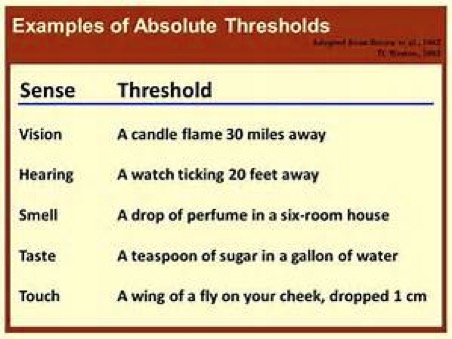
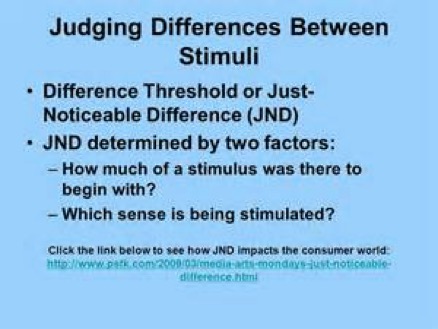
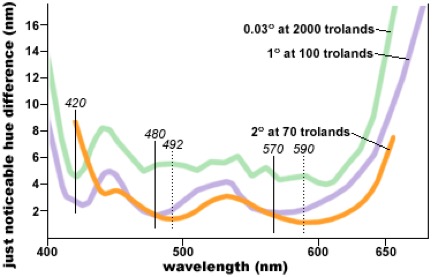
Indriya - the sense that the senses are intrinsically divine.
In yoga language, the senses are called indriya, इन्द्रिय - "belonging to Indra, the king of the gods." The senses are the companions of the divine. The senses are intrinsically divine - they have been created by nature, or by whatever created creation, as a way for us who are part of nature to perceive nature.
Indriya - "fit for or belonging to or agreeable to indra, faculty of sense, sense, organ of sense, the number five as symbolical of the five senses."
If you are hungry for MORE about the senses and sensations, there is more at svarasa.com.
The Language of Emotion
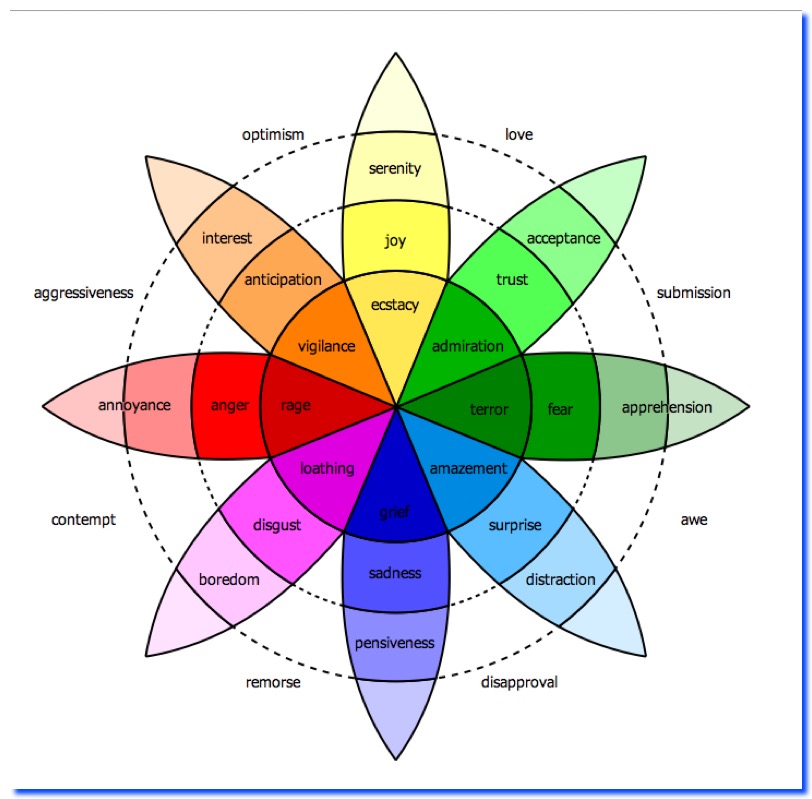
* based on the work of Robert Plutchik - "Plutchik's Emotion Wheel" see The Nature of Emotions
Emotions, Ruling Passions and Personality Traits
Some psychologists like to say there are eight primary emotions—anger, fear, sadness, disgust, surprise, anticipation, trust, and joy.
Others list the basic emotions as:
* fear
* anger
* joy
* sadness
* disgust
* interest
You can make your own map, based on your emotional experience of life and the kinds of people and situations you are encountering. Over time, develop a more nuanced and intricate map of the emotions, for this is much of what those on the Path of Intimacy experience in meditation moment by moment.
For meditators, the primary skill is acceptance of whatever their emotional experience is. We all need help learning to accept the range of emotional experience, support ourselves to be there, hold and cherish the parts of ourselves involved, allow experience to change and transmute, learn the lessons, and allow ourselves to be educated by our life experience.
We all have tendencies to accept certain experiences and reject others. This is good and healthy. There are times, however, when we have to learn new skills, learn to accept the unacceptable, or accept the next stage of our own development and evolution.
In psychological theory there are debates about what to include. For example, to some, love is considered to be a much more complex state than a simple emotion.
* abasement
* acceptance
* adoration
* adventurous
* affection
* agreeable
* aggression
* agony
* alarm
* amazement
* ambivalence
* amusement
* anger
* anguish
* animosity
* annoyance
* antagonism
* anticipation
* antipathy
* anxiety
* apathy
* appalled
* appetite
* apprehension
* approbation
* approval
* ardor
* arousal
* assertive
* astonishment
* attentive
* avarice
* averse
* avid
* awe
* balky
* bashful
* bewildered
* bitter
* bliss
* boastful
* bold
* boredom
* broad-mindedness
* calm
* capricious
* captious
* careless
* caring
* caution
* censorious
* cheerful
* cockiness
* compassion
* complacency
* conceit
* concern
* confusion
* consternation
* contempt
* content
* contrary
* cooperative
* cranky
* critical
* curiosity
* cynical
* daring
* daunted
* decisive
* defiance
* dejection
* delectation
* delight
* depression
* desire
* despair
* desperation
* despise
* despondent
* determination
* detestation
* devotion
* diffidence
* disagreeable
* disappointment
* discomposure
* disconcerted
* discontent
* discouragement
* disdain
* disgust
* disheartened
* disinclination
* disinterest
* dismay
* disobedience
* displeasure
* disquieted
* dissatisfaction
* distaste
* distress
* distrust
* doubt
* dread
* eager
* ecstasy
* effrontery
* egocentrism
* egoism
* elation
* embarrassment
* empty
* enjoyment
* enmity
* enthusiasm
* envy
* euphoria
* exasperation
* expectancy
* fault-finding
* fear
* fervor
* foolhardy
* frenzied
* fretful
* forward
* froward
* frustration
* fury
* gaiety
* gall
* generosity
* glad
* glee
* gloom
* greed
* grief
* grouchy
* guilt
* happiness
* hatred
* haughty
* helplessness
* hesitancy
* homesickness
* honor
* hope
* hopelessness
* horror
* hostility
* humiliation
* humility
* impassiveness
* impatience
* impudence
* impulsive
* indecision
* indifference
* indignation
* inhospitable
* insecurity
* insolence
* interest
* intolerance
* irresolution
* irritability
* irritation
* jealousy
* jocular
* jovial
* joy
* lasciviousness
* lethargy
* liberality
* lighthearted
* loathing
* lonely
* love
* lust
* malice
* malignity
* meek
* melancholy
* merry
* mirthful
* misanthropy
* miserable
* modesty
* mortification
* mysoginic
* mysoginism
* narcissism
* nervous
* nosiness
* nostalgia
* obedience
* obstinate
* offense
* optimism
* outrage
* pain
* panic
* paranoia
* partiality
* passion
* passivity
* patience
* peaceful
* peevish
* penitent
* pensive
* perplexity
* perturbed
* perverse
* pessimism
* petulance
* pique
* placidity
* playful
* pleasure
* possessive
* precocious
* prejudice
* pride
* puzzled
* querulous
* quiet pleasure
* radical
* rage
* rancor
* rapture
* rash
* rebellious
* receptive
* reckless
* refractory
* regret
* rejection
* reluctance
* remorse
* repentant
* repugnance
* resentment
* reserved
* resignation
* resolute
* restive
* restlessness
* reverence
* revulsion
* sadness
* sarcasm
* satisfaction
* savage
* scorn
* self-conscious
* self-control
* self-deprecation
* self-destructive
* self-reproach
* sensitivity
* serenity
* shaky
* shame
* shock
* shy
* skepticism
* sociable
* solicitude
* sorrow
* spite
* spontaneity
* startled
* stoic
* stubborn
* submissive
* suicidal
* sunny
* surprise
* surrender
* suspicion
* sympathy
* tension
* terror
* thoughtful
* timid
* tolerance
* tranquility
* trepidation
* triumph
* troubled
* trust
* umbrage
* unassertive
* uncertainty
* uneasiness
* unfriendly
* unhappy
* upset
* vanity
* vehemence
* vengeful
* venturesome
* vexation
* vigilance
* violation
* wariness
* warmhearted
* watchful
* wayward
* woeful
* wonder
* worry
* worship
* worthlessness
* wretched
* zeal
A great teaching movie: INSIDE OUT.
Inside Out clips.
The Language of the Instincts
I feel sleepy.
I am hungry.
I am horny.
I feel nourished by that music.
I want to go home.
I feel at home here.
I am lost.
Let's go shopping.
Let's go on an adventure.
I feel left out of their group.
I feel like I need to protect myself from him.
I don't trust her.
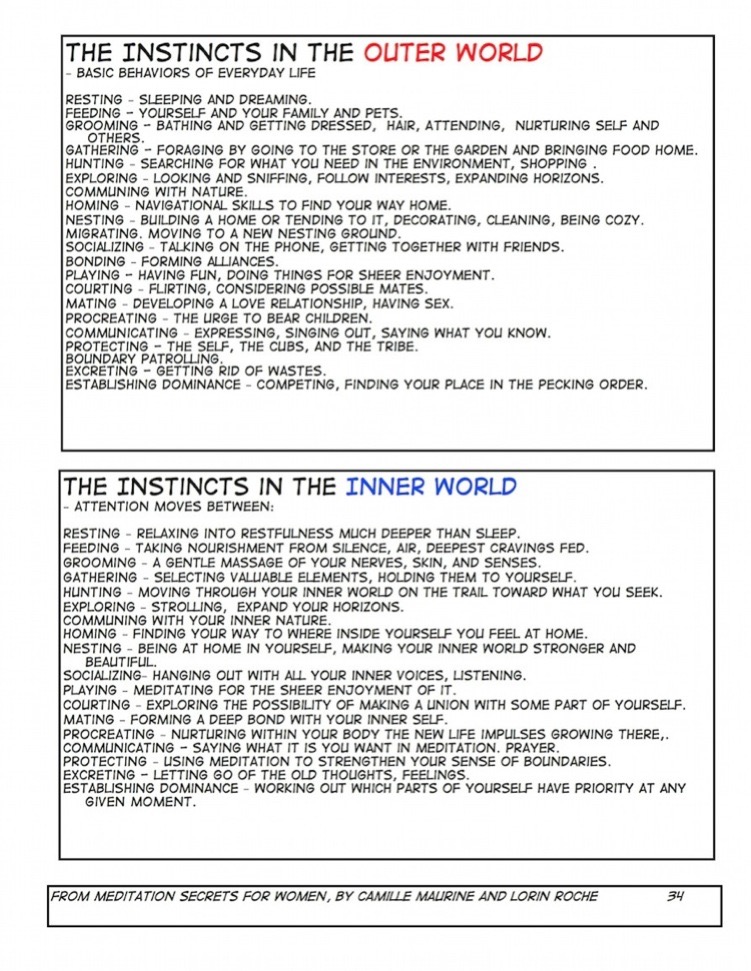
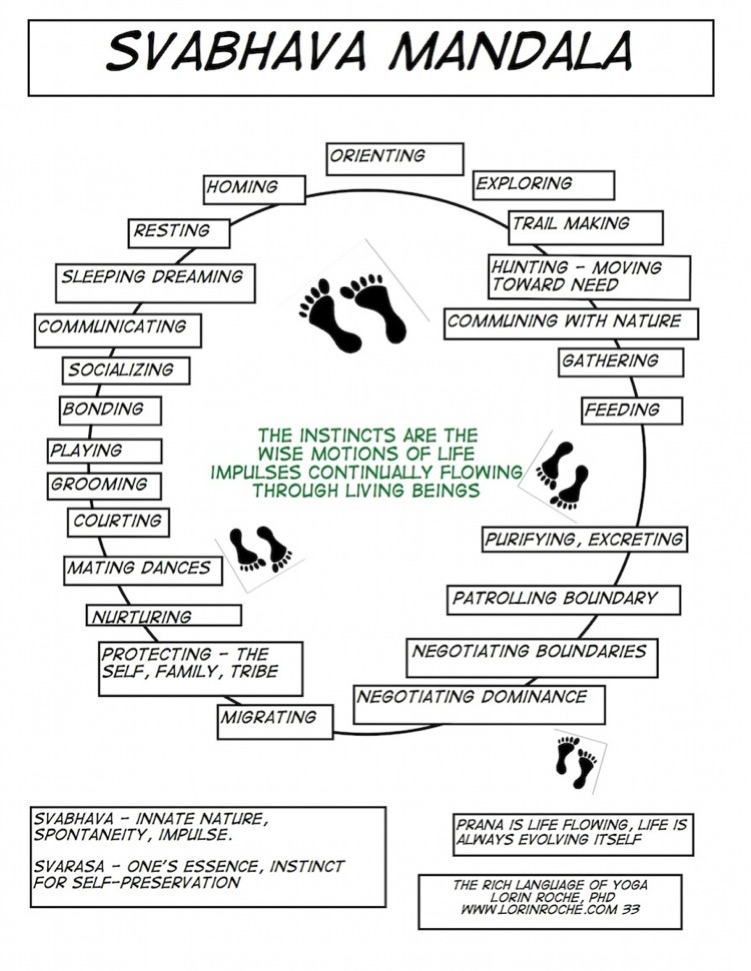
Senses and Emotions and Instincts and Elements, Oh My!
Why so many languages?
You can have your favorite meditation languages you specialize in:
-the dozen plus human senses
-the dozens of emotions
-the twenty or so major instincts and their manifestations
-the elements
Each of these describes a series of doorways into meditation and experiences one encounters.
When you are listening to students describe their natural gateways into meditation, it helps to be alert to this variety of languages.
If a woman says, "Well, gardening is a meditation for me," you need to get on your knees with her, for gardeners are often on their knees. Listen to her describe her tacit experience with the elements of gardening.
Some of the benefits of learning these languages ––
1 you can listen to almost anyone, of any type, and get a sense of their inner doorways
2 you can learn to be continually fascinated by your own experience and that of others. Meditation becomes more engaging. If you are doing it right, meditation is as absorbing as a novel, movie or video game –– or your iPhone.
3 you can experience your "inner noise" as a play of elements and senses. if you have ever been in nature, it is often very noisy. All the birds and crickets are calling out to each other, waves are crashing on the shore.